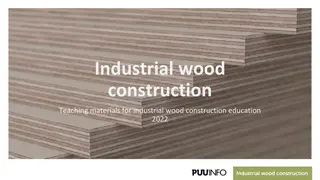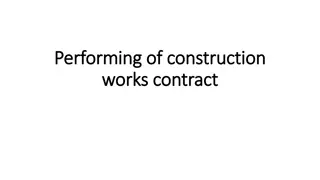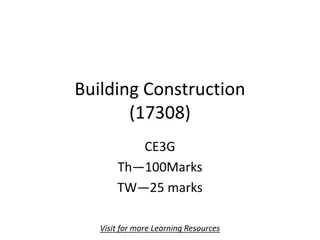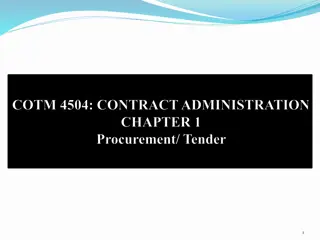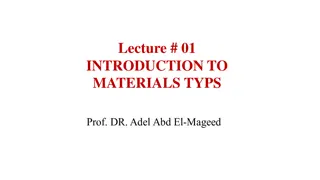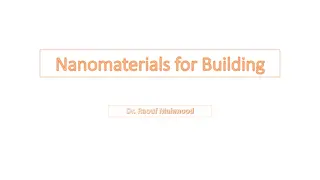Materials Selection Criteria in Construction
This content delves into the essential criteria for selecting materials in construction, covering mechanical properties, corrosion resistance, ease of fabrication, availability, and cost. It details the significance of tensile strength, stiffness, toughness, hardness, fatigue resistance, and creep resistance. Additionally, it explores the different types of corrosion and their impact on material durability.
Download Presentation

Please find below an Image/Link to download the presentation.
The content on the website is provided AS IS for your information and personal use only. It may not be sold, licensed, or shared on other websites without obtaining consent from the author.If you encounter any issues during the download, it is possible that the publisher has removed the file from their server.
You are allowed to download the files provided on this website for personal or commercial use, subject to the condition that they are used lawfully. All files are the property of their respective owners.
The content on the website is provided AS IS for your information and personal use only. It may not be sold, licensed, or shared on other websites without obtaining consent from the author.
E N D
Presentation Transcript
Materials and Fabrication Selection
Chapter outline: Classes of materials (categories of materials) Materials selection criteria Material properties Commonly used materials of construction Materials fabrication steps Economic selection of materials Analysis of failure for metals (types of failure, finding primary cause of failure and initiate corrective action to prevent repetition).
Materials selection criteria The most important characteristics (criteria) to be considered when selecting a material of construction are: 1. Mechanical and physical properties 2. Corrosion resistance 3. Ease of fabrication forming, welding, casting 4. Availability in standard sizes 5. Cost
1. Mechanical and physical properties a. Strength tensile strength; b. Stiffness: c. Toughness fracture resistance; d. Hardness wear resistance; e. Fatigue resistance; f. Creep resistance.
Tensile Strength (UTS) is a measure of the basic strength of a material. It is the maximum stress that the material will withstand, measured by a standard tensile test. Stiffness the ability to resist bending and buckling. It is a function of the elastic modulus of the material and the shape of the cross-section of the member. Toughness The ability to absorb impact energy. It is a measure of the materials resistance to crack propagation or measure of ductility.
Hardness is an indication of a materials ability to resist wear or scratching. This will be an important property if the equipment is being designed to handle abrasive solids, or liquids containing suspended solids which are likely to cause erosion. Fatigue Failure which is likely to occur in equipment subject to cyclic loading; for example, rotating equipment, such as pumps and compressors, and equipment subjected to temperature or pressure cycling. Creep Creep is the gradual extension of a material under a steady tensile stress, over a prolonged period of time. It is usually important only at high temperatures.
2. Corrosion resistance The conditions that cause corrosion can arise in a variety of ways. It is convenient to classify corrosion into the following categories: 1. Uniform corrosion; 2. Galvanic corrosion dissimilar metals in contact; 3. Pitting localized attack; 4. Intergranular corrosion; 5. Stress corrosion; 6. Erosion corrosion; 7. Corrosion fatigue; 8. High-temperature oxidation and sulfidation; 9. Hydrogen embrittlement.
Erosioncorrosion Increase in the rate of deterioration or corrosion because of relative movement between a corrosive fluid and the metal surface. Factors affecting rate of corrosion: 1. Nature of metal. 2. Surface film. 3. Velocity.
Hydrogen embrittlement loss of ductility caused by the absorption (and reaction) of hydrogen in a metal Ex: Hydrogen reforming plants H2embrittlement severity depends on: 1. Partial pressure of hydrogen 2. Temperature
SELECTION FOR CORROSION RESISTANCE In order to select the correct material of construction, the process environment to which the material will be exposed must be clearly defined. In addition to the main corrosive chemicals present, the following factors must be considered: 1. Temperature affects corrosion rate and mechanical properties; 2. Pressure; 3. pH; 4. Presence of trace impurities 5. The amount of aeration differential oxidation cells; 6. Stream velocity and agitation erosion-corrosion;
Acceptable Corrosion Rates ipy = inch per year mpy = mills per year ( 1 mill = 10-3inch)
Commonly used material of construction Iron and steel Alloy steel Nickel and its alloys Copper and its alloys Lead Aluminum
II- NONMETALS A. Plastic materials B. Ceramic materials A. PLASTICS AS MATERIALS OF CONSTRUCTION FOR CHEMICAL PLANTS They can be divided into two broad classes: 1. Thermoplastic materials, which soften with increasing temperature; for example, polyvinyl chloride (PVC) and polyethylene. 2. Thermosetting materials, which have a rigid, cross-linked structure; for example, the polyester and epoxy resins.
FAILURE-MODE EFFECT ANALYSIS [FMEA] Reasons for failure 1. Design deficiency 2. Materials problem 3. Overload (abuse)






